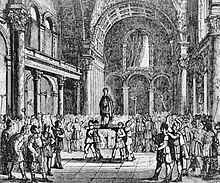Rabu, 03 April 2013

The history of Paris, France, spans over 2,000 years, during which time the city grew from a small Gallic settlement to the capital and primate city of France. It further developed into a center of art, medicine, science, fashion, tourism, high culture and high finance, becoming one of the world's major global cities.
Ancient place

Coins of the Parisii (Metropolitan Museum of Art).
It is believed that a settlement on the site of modern-day Paris was founded in about 250 BC by a Celtic tribe called the Parisii, who established a fishing village near the riverSeine. The Île de la Cité was traditionally assumed to be the location of the settlement, but this theory has been recently brought into question. Recent archeological finds indicate that the Paris region's largest pre-Roman settlement may have been in the present-day suburb of Nanterre.[1]
Paris's lands were prosperous, and occupied a strategic position for controlling river shipping and commerce. The area came under Roman control after the revolt of 52 BC when Vercingetorix led a Celtic uprising against the Romans under Caesar. The town sided with the rebels and was said to have contributed 8,000 men to Vercingetorix's army. It was garrisoned by Vercingetorix's lieutenant Camulogenus, whose army camped on the Mons Lutetius (where the Panthéon is now situated). The Romans crushed the rebels at nearby Melun and took control of the entire region. By the end of the same century, the Île de la Cité and Left Bank Sainte Geneviève Hill became the centre of a new Roman settlement called Lutetia.
Under Roman rule, the town was thoroughly Romanised and grew considerably. It was, however, not the capital of its province, Lugdunensis Senona—that role was played by Agedincum (modern Sens, Yonne). It was Christianised in the 3rd century when St Denisbecame the city's first bishop. The process was not entirely peaceful—in about 250 St Denis and two companions were arrested and decapitated on the hill of Mons Mercurius, thereafter known as Mons Martis (Martyrs' Hill, now Montmartre).
Lutetia, a Celtic name that may mean "dwelling surrounded by waters, was renamed Paris in 212after the local tribe, a sub tribe of the Senons, but the rest of the 3rd and 4th century was wracked by war and civil unrest. The city came under attack from barbarian invaders, prompting the construction of a defensive city wall. In 357, the Emperor Constantine's nephew Julian arrived in Paris to become the city's new governor. Although his uncle had declared Christianity the official religion of the Empire, Julian "the Apostate" strove to roll back its advance. He became emperor in 361 but died in battle only two years later.
Roman rule in northern Gaul effectively collapsed in the 5th century. In 451, the region was invaded by Attila the Hun, prompting fears that Paris would be attacked. According to legend, the city was saved by the piety of Sainte Geneviève and her followers, whose prayers for relief were answered when Attila's march turned away from Paris to the south. St. Geneviève remains Paris's patron saint to this day.
Langganan:
Posting Komentar (Atom)


0 komentar:
Posting Komentar